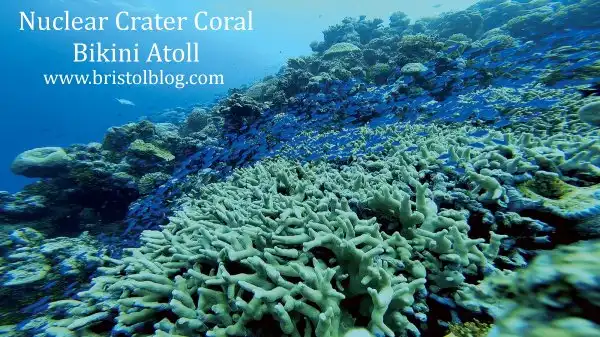Introduction
Nuclear sites like Bikini Atoll and Chernobyl, once devastated by radiation, now teem with life, showing nature’s resilience. Despite massive nuclear tests and accidents, ecosystems have recovered, from corals in bomb craters to wolves in exclusion zones. This resilience challenges fears about radiation’s long-term impacts and highlights the potential of nuclear power as a clean energy source. Using data from scientific studies, this page explores how life thrives in these “nuclear graveyards” and why nuclear energy—through innovations like breeder reactors and uranium extraction—offers a sustainable alternative to fossil fuels, reducing environmental harm while meeting energy needs.
Key Terms
Exclusion Zone: Area around a nuclear site restricted due to radiation, like Chernobyl’s 30-km radius (The Conversation, 2019).
Breeder Reactor: Nuclear reactor that generates more fuel than it consumes, using uranium or thorium (ResearchGate, 2023).
Megaton: Unit of explosive energy; 1 megaton equals 1 million tons of TNT (Stanley, 2009).
Nature’s Resilience: Bikini Atoll
Bikini Atoll in the Marshall Islands endured 23 nuclear detonations in the 1940s-50s, including a 4-6 megaton hydrogen bomb that left a crater 1 mile wide and 160 feet deep. Target ships spilled thousands of tons of oil into the lagoon, yet life has returned. Recent studies found thriving ecosystems in the bomb craters, with “abundant, big healthy coral communities—corals larger than cars” and schools of fish and reef sharks (The Conversation, 2019). Some corals began regrowing just a decade after the tests, despite massive fallout. This rapid recovery shows nature’s ability to adapt to extreme conditions, even in a heavily irradiated environment.
Nature’s Resilience: Chernobyl
Chernobyl’s 1986 disaster created a 30-km exclusion zone in Ukraine and Belarus, yet wildlife has flourished without human interference. Brown bears, wolves, lynxes, bison, moose, foxes, and over 200 bird species now inhabit the area (Newsweek, 2022). A 2019 meeting of researchers in Portsmouth, England, confirmed that animal and plant populations—including amphibians, fish, bumblebees, and bacteria—remain stable and viable, with no significant negative effects from current radiation levels (The Conversation, 2019). Tourism has also boomed, with over 70,000 visitors in 2018, showing the area’s transformation into a thriving nature preserve, highlighting nature’s resilience to nuclear fallout.
Nuclear Power: A Sustainable Solution
Nuclear power offers a clean alternative to fossil fuels, with innovations improving its efficiency. Breeder reactors can extract nearly all energy from uranium or thorium, reducing fuel needs by 100 times compared to traditional reactors, which use less than 1% of uranium’s energy (ResearchGate, 2023). Over 1 million tons of potential nuclear fuel sits in storage, reusable in breeder reactors, minimizing mining’s environmental impact. Additionally, uranium can be extracted from seawater—an estimated 4.5 billion metric tons—using non-polluting methods costing ~$300/kg with improved technology (ResearchGate, 2023). One kilogram of uranium replaces 2,500 tons of coal, cutting CO₂ emissions significantly. Unlike “green” energy, which often offshores pollution, nuclear power provides a sustainable, low-impact solution.

Conclusion
Bikini Atoll and Chernobyl show nature’s remarkable resilience, with corals and wildlife thriving in areas once thought uninhabitable. Corals larger than cars grow in bomb craters, and wolves roam Chernobyl’s exclusion zone, proving ecosystems can recover from nuclear events. This resilience supports the case for nuclear power as a clean energy source. Innovations like breeder reactors and seawater uranium extraction make nuclear energy efficient and sustainable, reducing environmental harm compared to fossil fuels. By focusing on data-driven solutions, we can meet energy needs while living in harmony with nature, learning from its ability to adapt and thrive.
Evidence based Earth Science
- Climate Change is not a Hoax - Bristol Blog
- Plant Stomata CO2 Climate Record - Bristol Blog
- Oceans Regulate Climate: Earth’s Resilience
- Answering the Eco-Luddites Fear of Technology
- Eco-Theology: Indoctrinating Kids, Breaking the Constitution
- Environmentalism as Religion: Dogma Over Data
- Lovelock, Earth vs. Venus, and Hansen’s Alarmism
- Venus Was Never Like Earth: Science Demands Proof
- Arctic Ice Defies Climate Models: A Case for Natural Cycles
- Nuclear power and radiation facts:
- Applied Science in Action: Nuclear Reactors and Radiation Realities in Southwest Virginia
- Solar, Wind are Climate Corporatism - Bristol Blog
- CANDU Reactors – A Clean Nuclear Solution
- Standardizing Nuclear Reactors and Cutting Politics
- Nuclear Graveyards Abound with Life
- What About Humans and Nuclear Radiation?
- Radiation Basics They Should Teach in High School
- Misconceptions About Radon: Data Over Fear in Public Policy
- Natural Radioactivity in Everyday Life: Separating Fact from Fear
- What Level of Knowledge Do You Need for Electronics Technology?
- Electronics and Technology for the Hobbyist and Home Scientist
References
- Newsweek. (2022). Wildlife returns to Chernobyl. Newsweek.
- ResearchGate. (2023). Uranium extraction from seawater. ResearchGate.
- The Conversation. (2019). Chernobyl as a refuge for wildlife. https://theconversation.com/chernobyl-has-become-a-refuge-for-wildlife-33-years-after-the-nuclear-accident-116303.
- Bristol Blog. (n.d.). Green Technology Highly Polluting. https://www.bristolblog.com/a/a4.htm.

